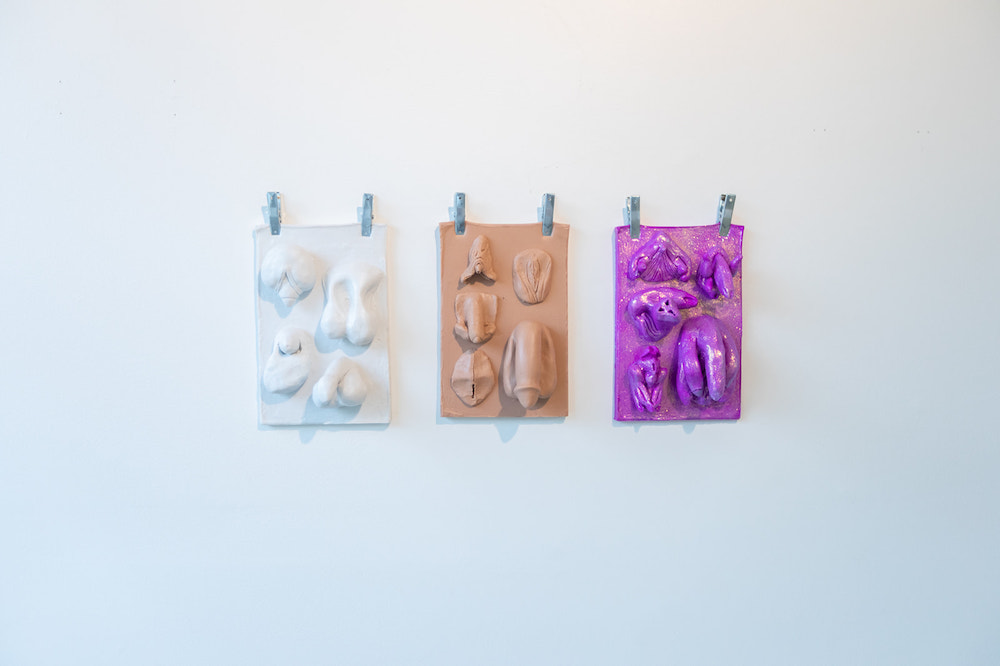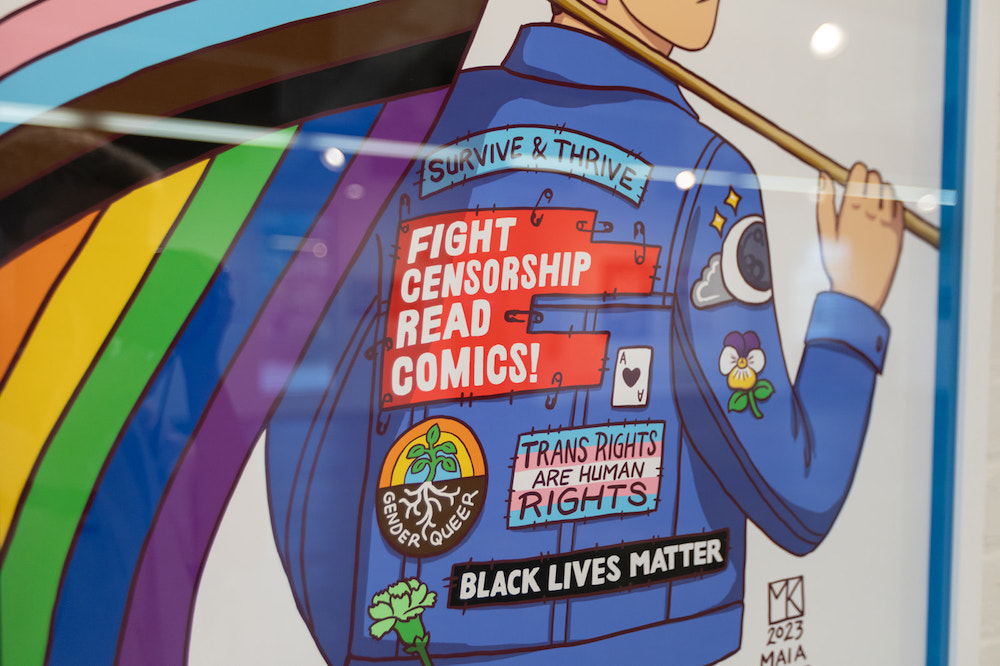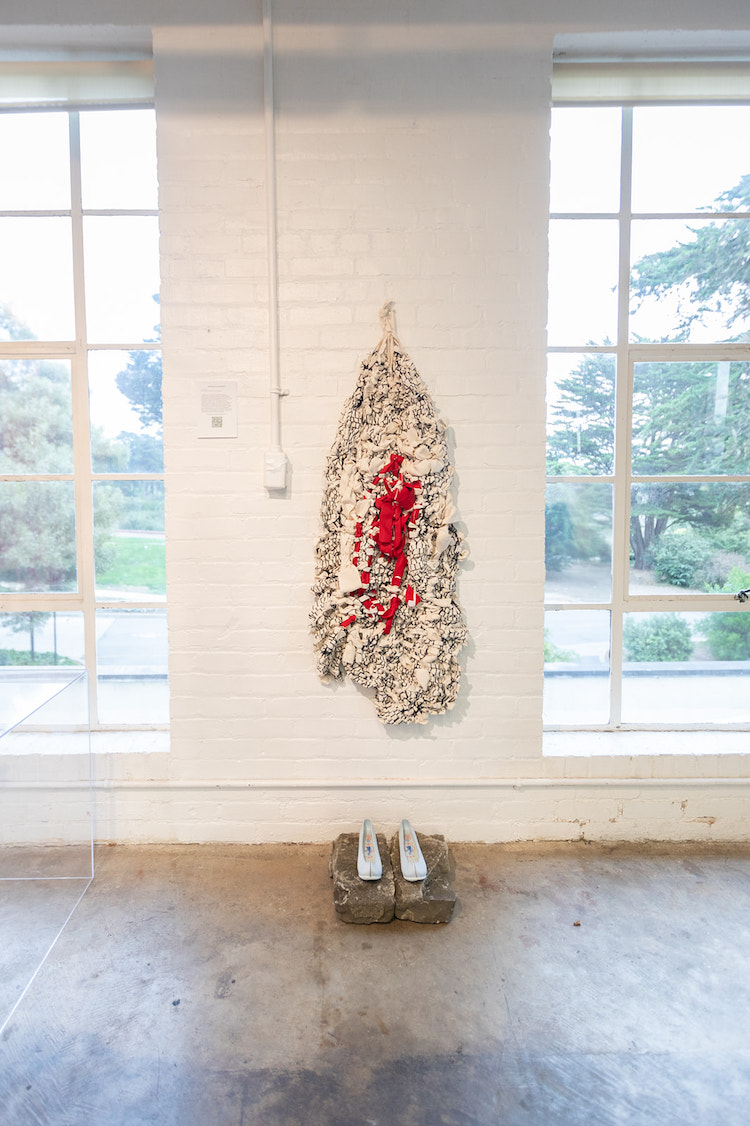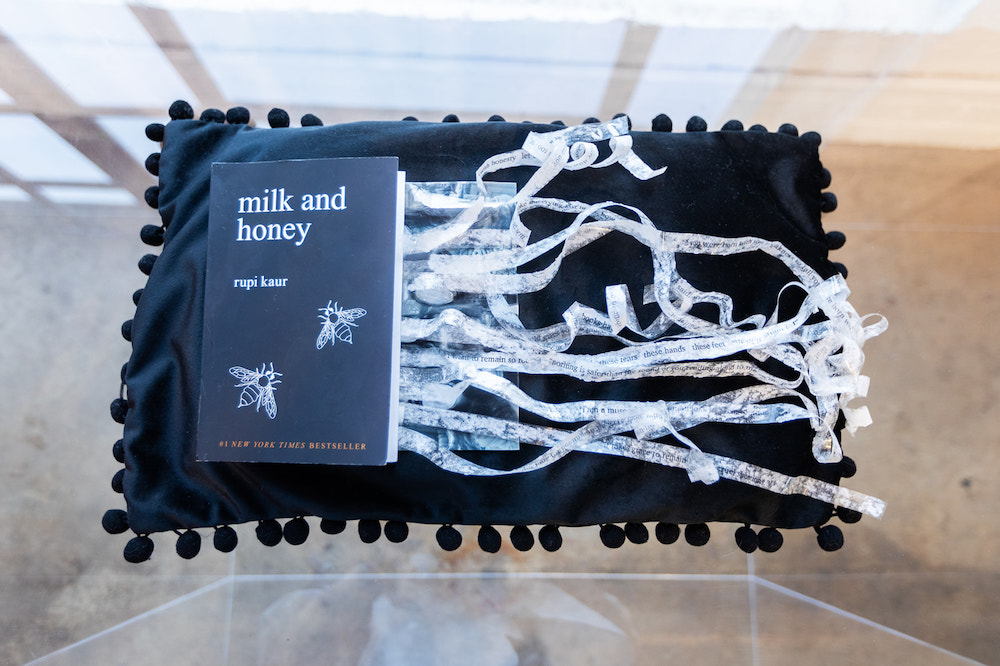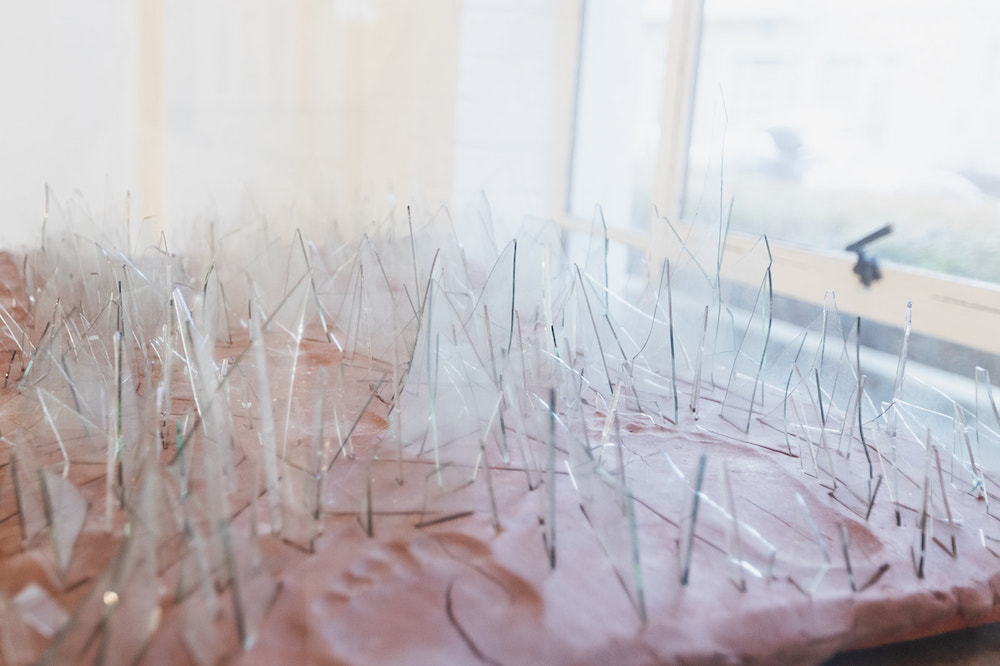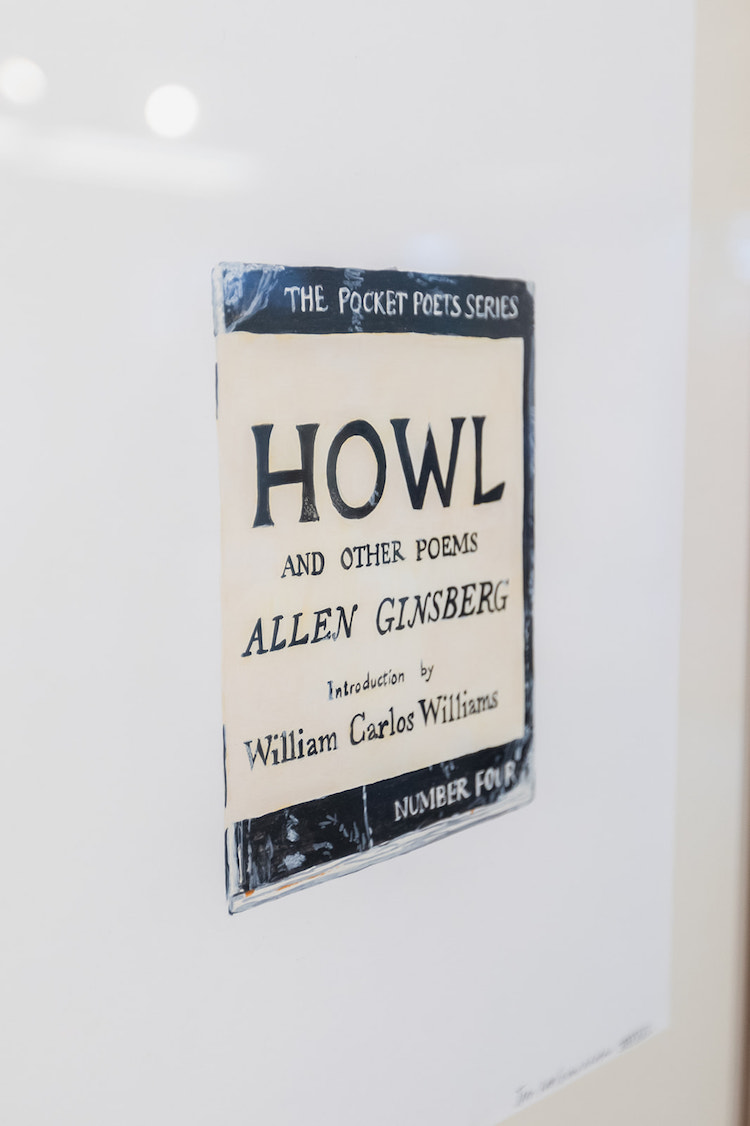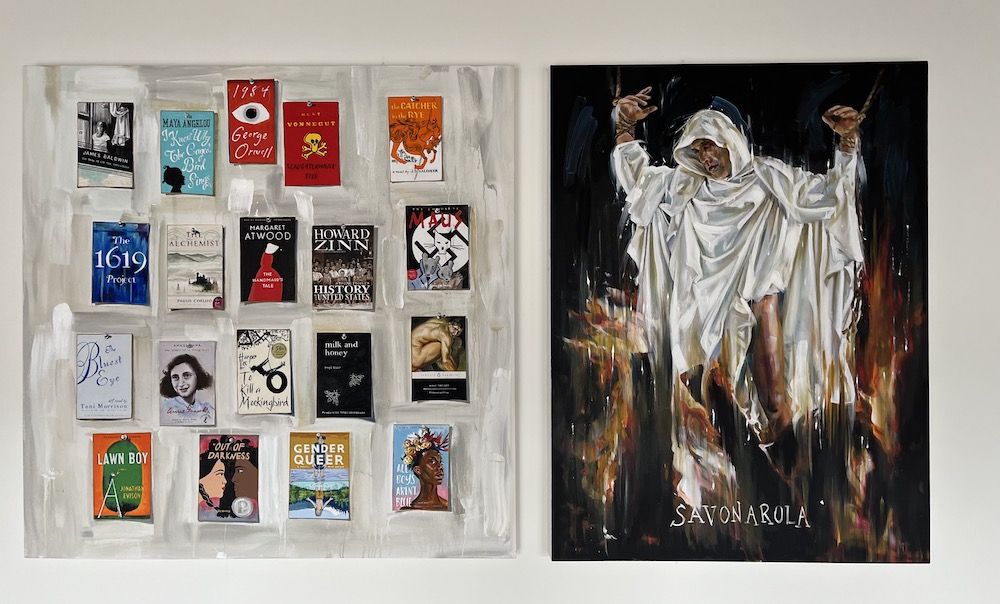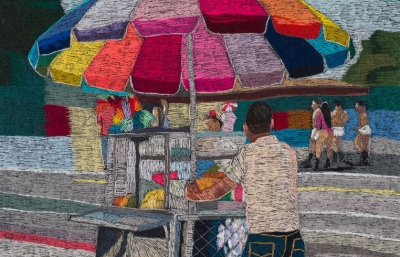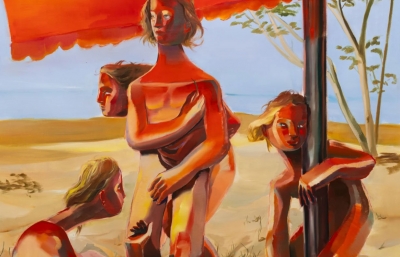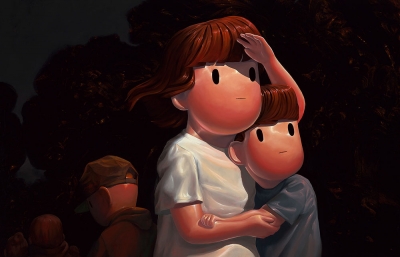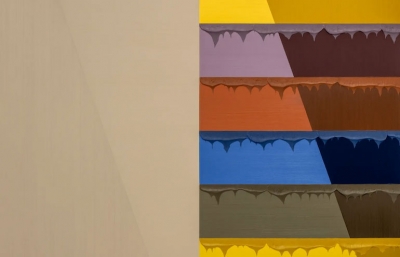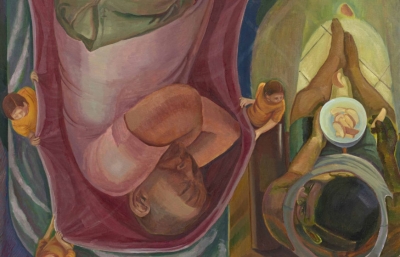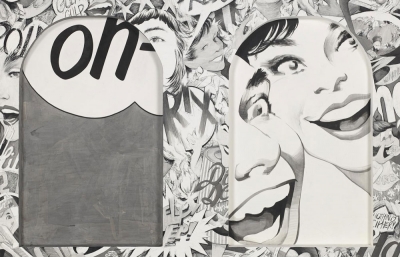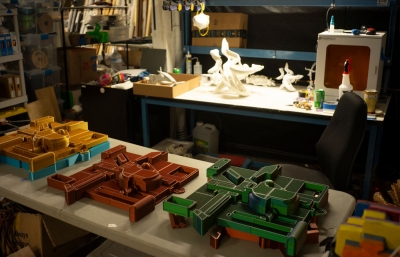Close on the heels of Banned Book Week 2023, the Arion Press presents an exhibition of 10 Bay Area Artists to spotlight contemporary and historical attempts to censor books in schools and libraries. No state in the nation has proven to be immune to the unprecedented number of attempts to ban books. According to the America Library Association, book challenges doubled last year and 2023 has seen a record 2,571 unique titles targeted for censorship. Most were by or about LGBTQIA= persons and Black, Indigenous, and people of color.
The (un)BANNED exhibition shines a light on the enduring importance of literature and the need to protect it from censorship. The works showcased encompass a diverse range of work from Donald Bradford, Sam Claude Carmel, Sahar Khoury, Maia Kobabe, Judith Selby Lang, Richard Lang, Kija Lucas, Michelle Yi Martin, Brian Singer, and Jean Pettigrew Whelen.
Donald Bradford: “Bulletin Board with Savanarola,” a diptych of acrylic and oil paintings draws a compelling parallel between banned books today and the actions of Savonarola, who initiated the Bonfire of the Vanities to burn "immoral" items. One panel captures a vivid depiction of the 15th-century monk suspended above licking flames and the other illustrates the covers of classics like George Orwell’s 1984 and contemporary books like George M. Johnson’s All Boys Aren’t Blue, which have faced censorship. Bradford’s arresting contribution stands as a powerful commentary on today's efforts to restrict access to knowledge and limiting intellectual freedom and cultural diversity.
Sam Claude Carmel: The artist, founder of San Francisco’s first trans-centering art gallery, has created 3 silicone panels ordered as past, present, and future ideas and representations of trans anatomy. Each work measures 6x9, the size of a paperback book, linking the human body with books themselves and reclaiming the narrative around trans anatomy that is so often distorted by those who seek to ban the books from which the artist drew inspiration. The “past” is a sculpture of genital forms referencing historical representations of trans people and androgynes in art. The “present” represents contemporary trans people’s genitalia, including hormonal, surgical, and dermal/piercing augmentation, sourced from Reddit transition forums and surgical journals, and featuring text-based tattoos from trans people carved into the silicon. The “future” captures speculative anatomies drawn from trans science fiction.
Sahar Khoury: The artist has populated a rolling wire paperback rack that’s seen better days – literally and metaphorically. The display pockets house no books and are largely empty but for a small bird’s nest (sans bird), a spray painted papier mache vase sports a grocery bag handle that Khoury’s has cleverly collaged onto the piece, and at the base is a ceramic heart with a gold crack that’s been affixed to one of the wheeled legs with a rusted hook. A warped file rack perches on top with only one slot filled; a ceramic word is half-visible: FEAR. Two ceramic tubes painted with the words WORSHIP and WARSHIP have also been slipped into the assemblage. The profound vacancy in this work speaks volumes, as does its affecting lyrical beauty.
Maia Kobabe: Kobabe is author and illustrator of Gender Queer, a book about coming out as nonbinary, which has placed em at the center of the fight over student access to literature. Kobabe's debut graphic memoir is currently the most banned book in the country. For this exhibition, Kobabe presents a framed fine art print of a self-portrait of the artist marching with the Trans and Intersex flags and wearing an array of text patches on the back of eir jacket, such as “Trans Rights are Human Rights” and “Fight Censorship Read Comics.”
Judith Selby Lang: The papers folded and tucked in the used books that Judith Selby Lang purchased for this project became treasured communiques from previous owners and sparked her 6 sculptural interventions. From coupons to snapshots to highlighted sections, Selby Lang weaves lyrical conversations with the authors of banned books and those who have read and continue to be inspired by them, including the artist herself. An explanatory blog provides brilliant accompaniment to the artwork, which includes Lady Chatterly’s Lover on a tufted pillow with the text lifted and entangled in transparent tape, symbolizing the continual attempts to silence this book. The Canterbury Tales is coiled in concentric circles, reflecting the complex, transgressive mores of its tales. Selby Lang's The Handmaid’s Tale takes on a life of its own, with text strands hanging like Handmaids' cloaks, a powerful metaphor for women's suppression.
Richard Lang: In the late 70s, the artist had a work of art banned from exhibition. Proposition 13, an initiative in California that slashed property taxes to boost the economy, ended up devastating education funding and costing him a teaching job at the College of Marin. In the wake of that loss, Lang was still invited to contribute to a faculty art show. He created "Leaving the Cave of the Tiger.” This piece, featuring footprints in wet clay and broken glass, was meant to be humorous but was deemed too strident and removed from the exhibition. For (un)BANNED, Lang has recreated this large-scale work to represent a release of long-held frustrations, a symbol of the fresh artistic chapter that followed the initial controversy, and as a call to action. An accompanying blog chronicles this engrossing story in greater detail.
Kija Lucas: Lucas presents 6 photographs of the title pages of books inherited from her late father's collection, many of which have been banned. These books, inscribed with wisdom, were her father's way of passing knowledge to his children, emphasizing the importance of critical thinking. Reading was difficult for her father, an undiagnosed dyslexic, but books were still a vital link for him, as they have been for Luca herself. One of these affecting images captures his inscription on a copy of Notes of a Native Son, a gift on the artist’s 16th birthday. Lucas points out that today's banned books often reveal hard truths about our history, racism, bias, gender, and sexuality. The banning of such voices seeks to preserve privilege and erase important context and history.
Michelle Yi Martin: “(un)bound” is a woven and knotted hanbok, traditional Korean attire, which was once banned during Japanese imperialism in Korea. This artwork beautifully envisions her grandparents' journey through censorship and genocide, reflecting on her own experiences. The cocoon or chrysalis-like shape symbolizes rebirth, hope, and the freedom to imagine, a critical aspect of breaking free from censorship. Yi Martin’s practice entails weaving the ancient language of fiber into conversation with other mediums, in this case stones and shoes, as a means of decoding the capacity for everyday objects and elements like sunlight to participate in storytelling, revealing the “in-between'' spaces where mystery and identity merge.
Brian Singer: In creating Kindling #1 and Kindling #2, the artist has cut pages from banned books into a variety of diverse enigmatic shapes with white paint serving as a metaphor for the attempts to erase and remove certain voices and ideas from public discourse. Only the edges are visible so the text is illegible. Singer has arranged these provocative relics on linen-wrapped wood panels, inviting contemplation of the hidden narratives within these silenced words. The title of these paired panels references the burning of books and the importance of preserving literature and intellectual freedom. The two large panels stand almost as pillars or portals to the realms of human imagination that make fresh modes of insight and connection possible.
Jean Pettigrew Whelen: The artist has composed two of her iconic “book stack” paintings. Pettigrew had asked a young trans friend what books had helped them navigate when they were questioning their gender. “Rory’s Stack” portrays the spines of these books, which the artist checked out of the San Francisco Public Library. The painting “For Toni Morrison” is a towering homage to the author’s monumental oeuvre. In addition to these acrylic on linen pieces, Whelen offers 3 smaller works on paper, which capture the covers of Allen Ginsberg’s Howl and Charles Bukowski’s Erections, ejaculations, exhibitions and general tales of ordinary madness.
The exhibition invites visitors to join the conversation, defend literary freedom, and support the diverse voices that challenge the status quo, spark dialogue, and promote a more inclusive and empathetic society. (un)BANNED through December 15, 2023 in the Arion Press Gallery in San Francisco.
Text by Tamsin Smith

